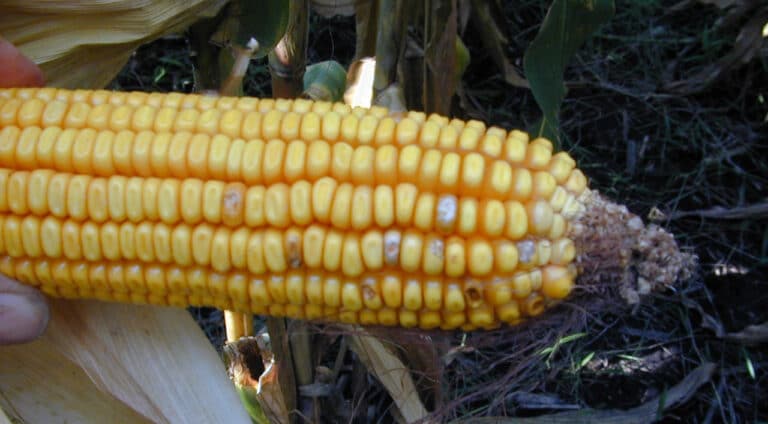Given the wet weather as of late, we may start seeing ear rots and molds. As we get into grain harvest, I am seeing molds and rots similar to a few years ago when we experienced mycotoxin issues due to the wet fall weather. If you are seeing these issues, you’re not the only one. Check out this article detailing Fusarium ear rot and the issues it may cause.
Introduction
Fusarium ear rot is a corn disease caused by the fungi Fusarium verticillioides, F. proliferatum and F. subglutanins. In all three species the disease symptoms are similar, but only F. verticillioides and F. proliferatum produce a group of mycotoxins called fumonisin which at high enough levels can be toxic
to animals, livestock, and humans.1 Fusarium ear rot can begin during or after flowering (R1 growth stage) and is most problematic when hot and dry weather is followed by periods of high humidity. Rain before harvest may intensify the contamination of fumonisins in corn. Due to health risks associated with mycotoxins, grain must be tested to determine fumonisin levels. Management practices can be implemented to help reduce the risk of Fusarium in future corn crops.
Fusarium Identification
Infected kernels have a white-to-pink cottony mold which are scattered around the ear (Figure 1). If Fusarium ear rot is suspected, scout fields at physiological maturity (R6 growth stage) to determine the severity.1 If the ear rot is widespread, harvest as early as possible to possibly reduce the level of fumonisin contamination and ear rot damage to kernels. At harvest grain must be tested to determine the level of fumonisin as toxin levels are not synonymous with visible ear rot symptomology. Fumonisin can be detected in a kernel that does not have any damage to the seed coat (pericarp). In order to know if a cornfield is impacted by mycotoxins, testing can be completed by an elevator with testing capabilities, grain exchanges, or an approved independent laboratory. Harvested grain should be dried, cooled, and cleaned immediately after harvest, and stored apart from grain harvested from healthy fields.
Sampling and Testing Procedures
Fumonisin does not occur uniformly in bulk corn, and grain handlers should sample in several areas of a load or bin. Contact a toxicology laboratory for specific sampling, handling instructions and analysis. There are a variety of commercial laboratories and quick-test kits for mycotoxin analysis. Romer Labs (www.romerlabs.com) and Neogen (www.neogen.com) sell test strips for fumonisin analysis. A farmer with contaminated grain has some options; however, contaminated grain cannot cross state lines and discounted prices are likely. Due to health risks associated with fumonisin, the United States Food and Drug Administration (FDA) has guidelines for the maximum amounts of fumonisin allowed in livestock feed (Table 1). Horses and pigs are more susceptible to fumonisin poisoning than cattle and poultry. If fumonisin contaminated grain is being used to make ethanol, the ethanol fermentation process increases the mycotoxin concentration levels in the distillers dried grain (DDG). Experiments have evaluated the mycotoxin concentrations in the DDGs and have reported to be approximately three times as high as the level in the grain. Molds can grow and mycotoxins can be produced in DDGs during transport, storage, and feeding at the farm which can further increase the fumonisin levels and danger when fed.2
Corn Product Selection
Corn product selection is an important step in managing Fusarium outbreaks in corn. Products with insect resistance traits (above ground Bt protection), drought tolerance and other traits that will reduce stress during critical periods for infection. Corn products with insect resistant traits that protect the ear from corn earworm, European corn borer, and Western bean cutworm may have lower levels of ear rot as insect feeding can create additional pathways for the disease to infect the kernels. Additionally, physical traits, such as downward position ears at maturity can help reduce the potential production of mycotoxins by allowing the ear to shed water quickly.
Management
• Crop rotation helps to minimize the carry-over of the pathogens from one year to the next.
• As Fusarium survives on crop residue tillage that buries the residue can help reduce the amount of inoculum for the following year crop. Tillage operations that only partially bury residue, such as chopping, disking, or chiseling, are also beneficial for pathogen reduction by helping breakdown crop residue.
• Optimize soil fertility to aid in plant health and reduce stress on the plant.
• Contact your local agronomist to select the best locally adapted corn products with proven disease tolerance or resistance.
Steps for Dealing with Mycotoxins
If mycotoxin is detected above the guidance levels established by the Food and Drug Administration (FDA), farmers must adhere to steps established by the United States Department of Agriculture’s Risk Management Agency. (https://www.rma.usda.gov/en/Policy-and-Procedure/Loss-Adjustment-Standards—25000) Farmers suspecting this issue should:
• Make insurance provider aware of suspected issue prior to harvest, storage or destruction of the cornfield.seedway.com
• Adjuster must collect samples of the Representative Sample Area (RSA) prior to the grain entering storage or the destruction of the field. Only the adjuster is approved to obtain samples from the standing crop.
• An Approved Insurance Provider (AIP)-Approved Testing Facility (i.e. laboratory) must complete analysis of these samples.5,6
• Farmers with questions regarding handling protocol should contact their insurance provider.


